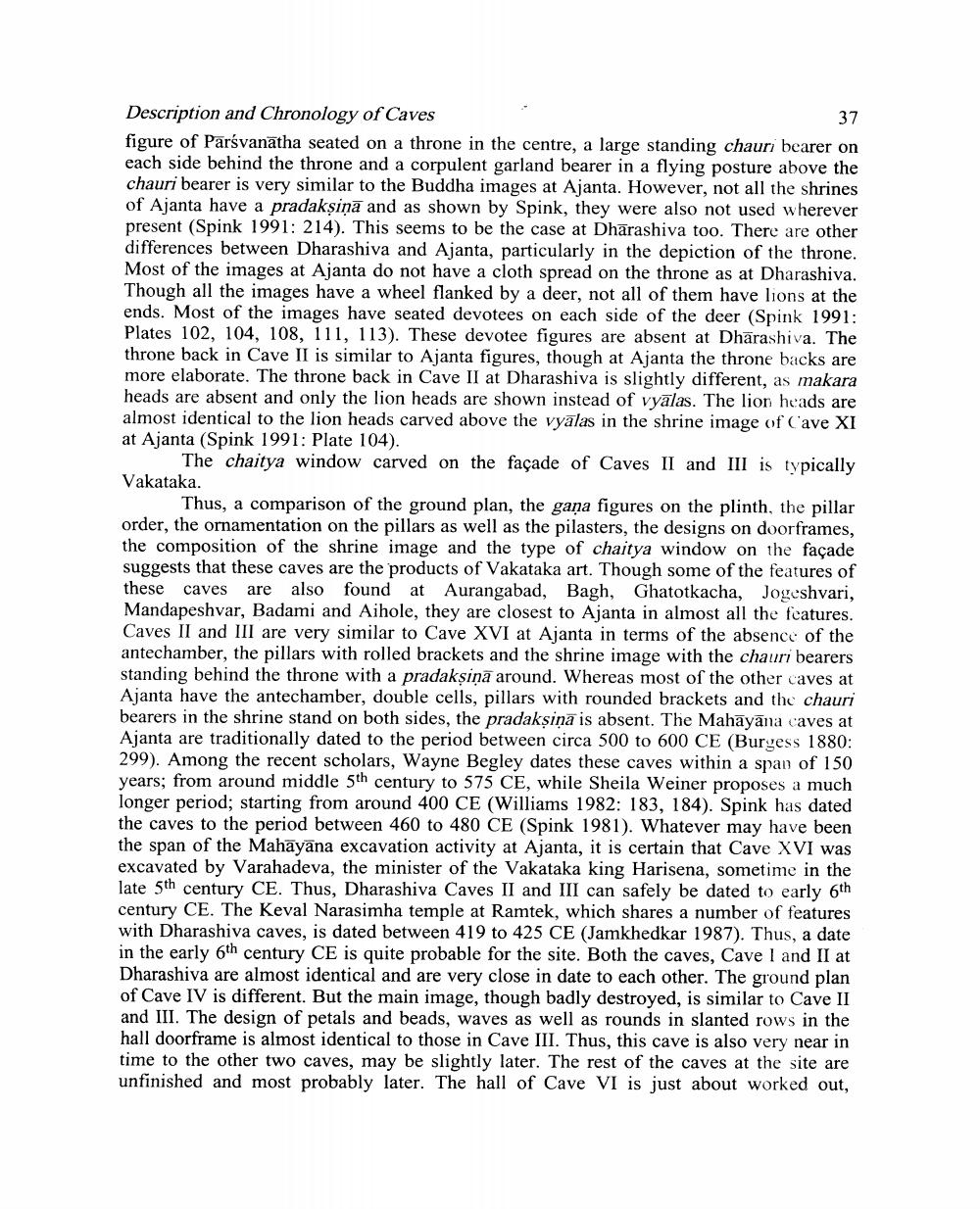________________
Description and Chronology of Caves figure of Parśvanātha seated on a throne in the centre, a large standing chauri bearer on each side behind the throne and a corpulent garland bearer in a flying posture above the chauri bearer is very similar to the Buddha images at Ajanta. However, not all the shrines of Ajanta have a pradaksiņā and as shown by Spink, they were also not used wherever present (Spink 1991: 214). This seems to be the case at Dhārashiva too. There are other differences between Dharashiva and Ajanta, particularly in the depiction of the throne. Most of the images at Ajanta do not have a cloth spread on the throne as at Dharashiva. Though all the images have a wheel flanked by a deer, not all of them have lions at the ends. Most of the images have seated devotees on each side of the deer (Spink 1991: Plates 102, 104, 108, 111, 113). These devotee figures are absent at Dhārashiva. The throne back in Cave II is similar to Ajanta figures, though at Ajanta the throne backs are more elaborate. The throne back in Cave II at Dharashiva is slightly different, as makara heads are absent and only the lion heads are shown instead of vyalas. The lion heads are almost identical to the lion heads carved above the vyalas in the shrine image of Cave XI at Ajanta (Spink 1991: Plate 104).
The chaitya window carved on the façade of Caves II and III is typically Vakataka.
Thus, a comparison of the ground plan, the gaņa figures on the plinth, the pillar order, the ornamentation on the pillars as well as the pilasters, the designs on doorframes, the composition of the shrine image and the type of chaitya window on the façade suggests that these caves are the products of Vakataka art. Though some of the features of these caves are also found at Aurangabad, Bagh, Ghatotkacha, Jogeshvari, Mandapeshvar, Badami and Aihole, they are closest to Ajanta in almost all the features. Caves II and III are very similar to Cave XVI at Ajanta in terms of the absence of the antechamber, the pillars with rolled brackets and the shrine image with the chauri bearers standing behind the throne with a pradaksiņā around. Whereas most of the other caves at Ajanta have the antechamber, double cells, pillars with rounded brackets and the chauri bearers in the shrine stand on both sides, the pradaksina is absent. The Mahāyāna caves at Ajanta are traditionally dated to the period between circa 500 to 600 CE (Burgess 1880: 299). Among the recent scholars, Wayne Begley dates these caves within a span of 150 years; from around middle 5th century to 575 CE, while Sheila Weiner proposes a much longer period; starting from around 400 CE (Williams 1982: 183, 184). Spink has dated the caves to the period between 460 to 480 CE (Spink 1981). Whatever may have been the span of the Mahayana excavation activity at Ajanta, it is certain that Cave XVI was excavated by Varahadeva, the minister of the Vakataka king Harisena, sometime in the late 5th century CE. Thus, Dharashiva Caves II and III can safely be dated to early 6th century CE. The Keval Narasimha temple at Ramtek, which shares a number of features with Dharashiva caves, is dated between 419 to 425 CE (Jamkhedkar 1987). Thus, a date in the early 6th century CE is quite probable for the site. Both the caves, Cave I and II at Dharashiva are almost identical and are very close in date to each other. The ground plan of Cave IV is different. But the main image, though badly destroyed, is similar to Cave II and III. The design of petals and beads, waves as well as rounds in slanted rows in the hall doorframe is almost identical to those in Cave III. Thus, this cave is also very near in time to the other two caves, may be slightly later. The rest of the caves at the site are unfinished and most probably later. The hall of Cave VI is just about worked out,




